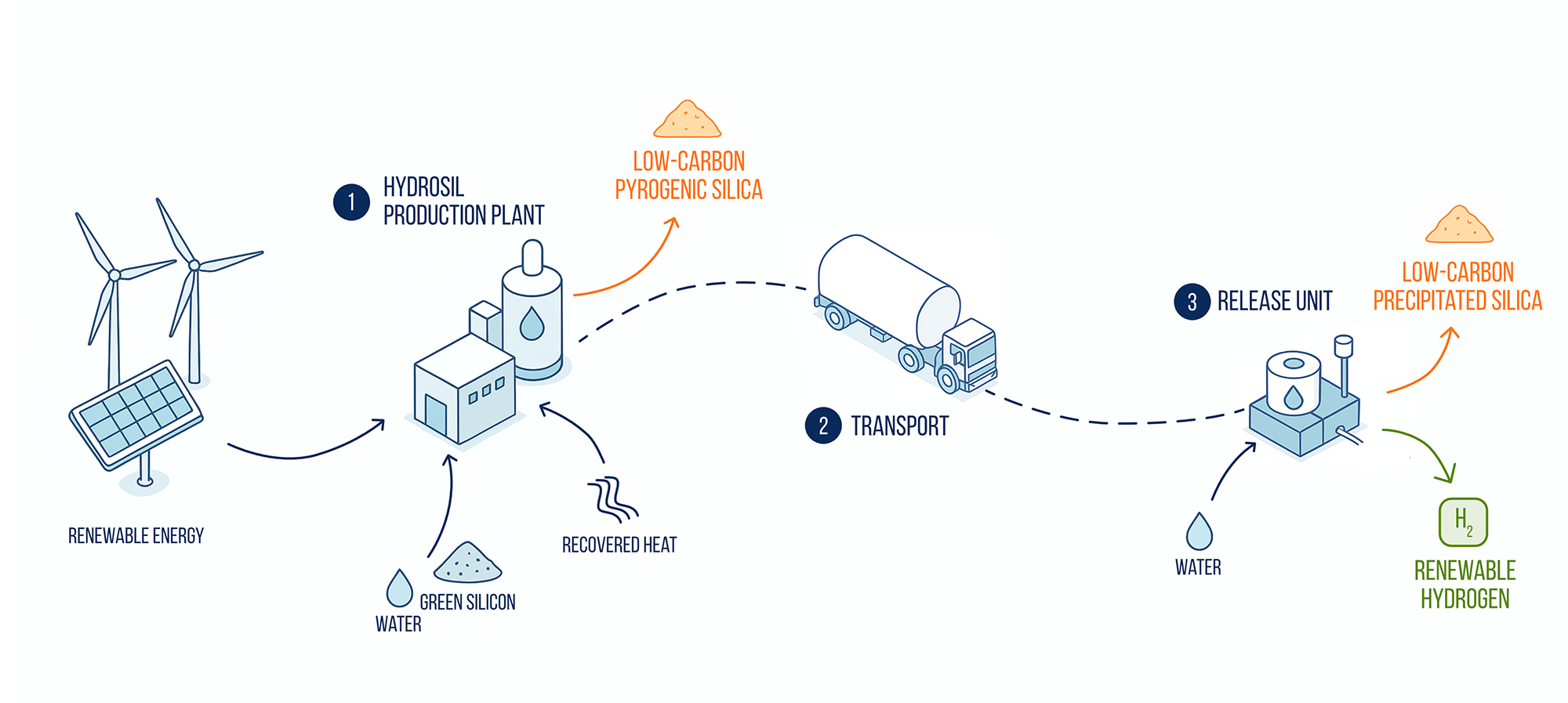HydroSil is a breakthrough liquid carrier that enables energy-free hydrogen release while producing high-performance, low-carbon silica.
HSL Technologies has conceived the first carrier to transport and store hydrogen & silica at ambient temperature and pressure in liquid state with a non-organic basis.
We develop a solution called HydroSil, grafting hydrogen onto silica to store and transport them, then releasing high quality products under ambient conditions.
This solution offers great perspectives for green hydrogen hubs, heavy industries’ decarbonization and many other applications.

inputs
Renewable resources like green electricity, biomass reductants and green silicon generating recoverable heat.
production
Forming a stable liquid by recovering industrials fatal heat and valorizing silica co-product from a CO2 emission-free process
storage & transport
At ambient temperature and pressure. Using existing optimized infrastructures, reducing transportation carbon footprint
release
Minimal energy process to release high pressure hydrogen (50 bar) and low carbon precipitated silica on demand
2026
– Release pilot
– Polymerization unit
– Hydrochlorination pilot
2027-2028
– Precipitated silica
Silica powder production pilot
– Permitting & Feed
Middle plant
– Middle release
50 kWe unit
2029-2030
– Middle production plant
Pre-commercial scale
10 t H2 / year
187 t silicas / year
– Industrial release
1 MW unit
2032
– Industrial release
14 x 1 MW unit
– Production plant
10 kt H2 / year
187 kt silicas / year
Our timeline - From the kg to the ton of H2
HSL Technologies is accelerating the adoption of HydroSil to reduce emissions and drive sustainable innovation. Our breakthrough liquid carrier enables safe, cost-effective storage and transport using existing infrastructure, overcoming long-standing challenges in the hydrogen value chain.
Beyond hydrogen, our process unlocks the valorization of silica, transforming a by-product into a valuable, low-carbon material for industrial use. This dual benefit strengthens our commitment to circularity and decarbonization.
By 2030, HSL aims to deploy large-scale hydrogen storage and support green hydrogen imports, helping meet the world’s growing clean energy demand. We envision a future where hydrogen and silica together power a resilient, low-carbon economy.
hydrosil advantages
HydroSil is a breakthrough liquid carrier that enables on demand hydrogen release while producing high-performance, low-carbon silica.
Designed for compatibility with existing infrastructure, it offers safe, scalable, and eco-friendly solutions for both hydrogen storage and silica valorization.
With up to 50% CO₂ reduction, optimized material density, and non-toxic, non-pyrophoric properties, HydroSil supports sustainable industry transformation, delivering 187 tons of silica per ton of hydrogen released.
ECO-FRIENDLY & LOW CARBON
– Minimal energy input | 5 kWh for 1 kg of low-carbon silica
– Non-toxic and non-pyrophoric
– Around 50% of CO₂ reduction with our low-carbon silica
LOW-CARBON SILICA VALORIZATION
– Silica generation | 150 ktons for 1 kton of H₂ released
– Economic and environmental synergy
– Optimized density | store 3× more than standard silica
INFRASTRUCTURE COMPATIBILITY
– Works with existing systems
– Pumpable & easy to handle | viscosity 100–200 mPa·s
– Supports wide-scale deployment
SAFETY & EFFICIENCY
– High safety thresholds | flash point >60 °C
– Competitive H₂ density | 7× more than compressed gas
– Transport under ambient conditions
AFFORDABLE MATERIAL, STRONGER PERFORMANCE
– No hydrogen used in production
– Abundant and affordable inputs
– Sustainable energy sourcing
ON DEMAND HYDROGEN RELEASE
– Minimal energy input
– Compressorless pressurization
– High quality H₂ | spec grade D

